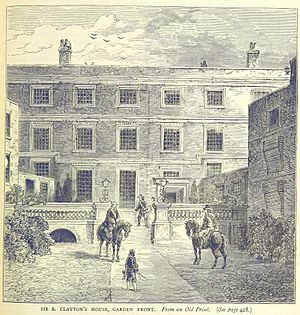Old Jewry facts for kids

The southern end of Old Jewry where it meets Poultry
|
|
| Length | 145 m (476 ft) |
|---|---|
| Location | London, United Kingdom |
| Postal code | EC2 |
| Nearest train station | |
| South end | Poultry |
| To | Gresham Street |
| Other | |
| Known for | Location of medieval Jewish community |

Old Jewry is a street in the City of London. This area is London's historic and financial heart. It is a one-way street. Old Jewry connects Poultry to Gresham Street.
Today, the street is mostly home to offices for financial companies. The closest London Underground station is Bank. The nearest main train station is Cannon Street.
Contents
A Look Back: Old Jewry's History
Jewish Community in Medieval London
After the Norman Conquest, William the Conqueror invited Jewish people to England. Many settled in different cities, including London. Old Jewry became a special area for them. It was like a "ghetto," which is a part of a city where a specific group of people, often Jews, lived. This was common in Europe back then.
In 2001, archaeologists found something interesting near Old Jewry. They discovered a mikveh, which is a special bath used for religious cleansing. This mikveh was found under what is now the State Bank of India. It would have stopped being used after 1290. This was when all Jewish people were forced to leave England.
Churches and Discoveries
On the west side of Old Jewry, you can find St Olave Old Jewry. Only the tower of this old church remains today. When the church was destroyed in 1887, workers found Roman pavement and old vases. This shows how old the area is!
Another nearby church is St Lawrence Jewry. It is a Church of England church. It stands on Gresham Street, right next to the Guildhall. There was also a street called Jewen Street. It was once the only place where Jewish people could be buried.
Famous People and Places
A famous artist named Thomas Rowlandson was born on Old Jewry in 1756. For many years, the main office for the City of London Police was also located on Old Jewry.
See also
- Bank junction
- Cheapside
- Ironmonger Lane
- Lothbury

